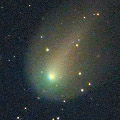
|
It brightened rapidly in outburst in mid October. Now it is bright as 8.5 mag (Feb. 4, Marek Biely). It keeps 8-9 mag for a long time until early summer, and it keeps observable in the morning sky in the Northern Hemisphere. In the Southern Hemisphere, it is getting higher and it will be observable in excellent condition after spring.
Date(TT) R.A. (2000) Decl. Delta r Elong. m1 Best Time(A, h)
Feb. 8 18 21.87 3 53.8 2.069 1.610 49 8.2 5:27 (288, 30)
Feb. 15 18 41.50 2 41.6 2.046 1.601 50 8.2 5:21 (289, 30)
|
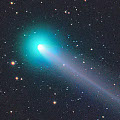
|
It passed only 0.4 A.U. from the earth, and 0.8 A.U. from the sun in November and December, and brightened up to 4.7 mag (Nov. 28, Juan Jose Gonzalez). Now it is 7.8 mag (Feb. 4, Marek Biely). In the Northern Hemisphere, it keeps observable in excellent condition for a long time until 2014 autumn when the comet will fade out. It is appearing in the morning sky again also in the Southern Hemisphere, and it keeps observable in good condition after this.
Date(TT) R.A. (2000) Decl. Delta r Elong. m1 Best Time(A, h)
Feb. 8 18 18.15 5 51.4 1.529 1.188 50 8.7 5:27 (287, 32)
Feb. 15 18 23.62 3 57.5 1.562 1.277 54 9.3 5:21 (291, 34)
|

|
Now it is bright as 12.4 mag (Feb. 7, Chris Wyatt). It is expected to brighten up to 5-6 mag in 2014 autumn. In the Northern Hemisphere, it will be getting higher gradually after this, and it keeps observable in good condition for a long time. It keeps locating low in the Southern Hemisphere.
Date(TT) R.A. (2000) Decl. Delta r Elong. m1 Best Time(A, h)
Feb. 8 16 36.00 15 1.5 3.117 3.061 77 11.3 5:27 (300, 57)
Feb. 15 16 36.93 16 30.3 2.929 2.982 83 11.1 5:21 (304, 62)
|

|
It brightened very rapidly in mid November, from 15 mag to 9 mag only within a week. Now it is bright as 11.7 mag but diffuse (Feb. 2, Carlos Labordena). It will be fading after this. It is observable in excellent condition in the Northern Hemisphere. It keeps locating extremely low in the Southern Hemisphere.
Date(TT) R.A. (2000) Decl. Delta r Elong. m1 Best Time(A, h)
Feb. 8 11 19.56 51 46.1 1.088 1.930 136 12.0 2:09 (180, 73)
Feb. 15 11 14.01 53 24.7 1.156 1.991 136 12.3 1:36 (180, 72)
|

|
New bright comet discovered in the STEREO spacecraft images. It was 7 mag on Feb. 1, but it became faint and diffuse very rapidly and faded down to 12 mag on Feb. 4. It will approach to the Sun down to 0.5 a.u. on Feb. 18. However, it will be disintegrated soon. It is appearing in the morning sky in the Northern Hemispehre. In the Southern Hemispehre, it will not observable after this. But it must have been observable in excellent condition in 2013.
Date(TT) R.A. (2000) Decl. Delta r Elong. m1 Best Time(A, h)
Feb. 8 20 10.13 -14 32.3 1.414 0.568 18 12.1 5:27 (286, -3)
Feb. 15 20 14.37 -7 33.4 1.202 0.516 24 12.4 5:21 (283, 5)
|

|
It will pass the perihelion on Feb. 15, and will brighten up to 12 mag. It is appearing in the evening sky in the Northern Hemisphere. It will be observable also in the Southern Hemisphere in early March. Then it keeps observable while the comet will fade out very rapidly.
Date(TT) R.A. (2000) Decl. Delta r Elong. m1 Best Time(A, h)
Feb. 8 22 47.71 -9 18.9 1.436 0.624 20 12.5 19:00 ( 77, 2)
Feb. 15 23 29.63 -6 37.4 1.346 0.608 24 12.1 19:06 ( 78, 5)
|

|
First return of a new periodic comet discovered in 1998. It brightened up to 10 mag at the discovery. Now it is 12.7 mag (Jan. 28, Chris Wyatt). A bit fainter than originally expected. But in the Northern Hemisphere, it keeps observable in excellent condition from autumn to spring. It locates somewhat low in the Southern Hemisphere.
Date(TT) R.A. (2000) Decl. Delta r Elong. m1 Best Time(A, h)
Feb. 8 6 12.75 29 39.4 1.378 2.178 133 12.1 20:59 ( 0, 85)
Feb. 15 6 14.54 28 3.7 1.426 2.170 127 12.2 20:34 ( 0, 83)
|
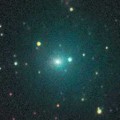
|
It brightened very rapidly, and brightened up to 10.5 mag from autumn to winter. It is bright as 11.6 mag still now (Jan. 19, Taras Prystavski). It will be fading after this. In the Northern Hemisphere, it keeps observable in excellent condition until May when it becomes fainter than 18 mag. It will not be observable after this in the Southern Hemisphere.
Date(TT) R.A. (2000) Decl. Delta r Elong. m1 Best Time(A, h)
Feb. 8 1 29.96 28 30.5 1.728 1.728 73 13.1 19:00 ( 91, 55)
Feb. 15 1 50.70 29 57.9 1.802 1.757 71 13.5 19:06 ( 95, 53)
|
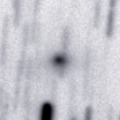
|
It brightened up to 2 mag by unusual major outburst in 2007. It is coming back now. It will be 14 mag at best by normal prediction. But actually, it is already very bright as 13.5 mag (Nov. 25, Hidetaka Sato). Now it is not observable. It will appear in the morning sky in May.
Date(TT) R.A. (2000) Decl. Delta r Elong. m1 Best Time(A, h)
Feb. 8 21 58.67 -10 59.5 3.058 2.090 9 13.6 19:00 ( 83, -9)
Feb. 15 22 13.05 -9 2.2 3.060 2.081 6 13.6 19:06 ( 87,-12)
|

|
It brightened up to 11-12 mag in 2012. Now it is 14.1 mag (Jan. 26, Taras Prystavski). It will be observable in good condition at 14 mag until 2014 early summer.
Date(TT) R.A. (2000) Decl. Delta r Elong. m1 Best Time(A, h)
Feb. 8 13 15.46 -14 21.2 6.596 7.084 115 13.8 4:05 ( 0, 41)
Feb. 15 13 11.24 -14 9.4 6.518 7.117 123 13.8 3:33 ( 0, 41)
|
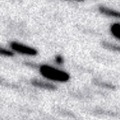
|
It reaches up to 12 mag in 2014 spring. But the condition in this apparition is bad. It locates low around the brightest days. Now it is not observable. It will appear in the morning sky at 13 mag in late July.
Date(TT) R.A. (2000) Decl. Delta r Elong. m1 Best Time(A, h)
Feb. 8 22 35.33 -5 24.2 2.878 1.978 19 14.0 19:00 ( 82, 2)
Feb. 15 22 51.17 -4 8.3 2.867 1.943 16 13.8 19:06 ( 86, -1)
|
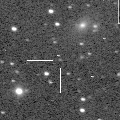
|
Already bright as 14.4 mag (Jan. 3, Mt. Lemmon Survey). It will brighten up to 13 mag and to be observable in excellent condition from spring to summer.
Date(TT) R.A. (2000) Decl. Delta r Elong. m1 Best Time(A, h)
Feb. 8 13 54.88 -12 51.8 2.235 2.704 107 14.0 4:44 ( 0, 42)
Feb. 15 13 59.99 -13 10.5 2.136 2.687 113 13.9 4:21 ( 0, 42)
|

|
Now it is 14.7 mag (Jan. 27, Taras Prystavski).
Date(TT) R.A. (2000) Decl. Delta r Elong. m1 Best Time(A, h)
Feb. 8 15 50.76 -29 21.2 6.307 6.165 77 13.9 5:27 (343, 23)
Feb. 15 15 53.46 -29 38.1 6.195 6.163 83 13.9 5:21 (347, 24)
|

|
Now it is bright as 13.2 mag (Jan. 28, Taras Prystavski). It keeps 13-14 mag and observable in good condition in the Northern Hemisphere for a long time from 2013 to 2014. In the Southern Hemisphere, it is not observable until 2014 autumn.
Date(TT) R.A. (2000) Decl. Delta r Elong. m1 Best Time(A, h)
Feb. 8 23 34.10 63 10.9 3.461 3.468 82 13.9 19:00 (147, 40)
Feb. 15 23 45.13 61 7.8 3.559 3.476 77 14.0 19:06 (144, 37)
|
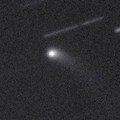
|
Now it is 13.9 mag and visible visually (Feb. 1, Chris Wyatt). It keeps 14 mag for a long time until 2014 summer. It keeps observable in good condition in the Northern Hemisphere. It is observable only until February in the Southern Hemisphere.
Date(TT) R.A. (2000) Decl. Delta r Elong. m1 Best Time(A, h)
Feb. 8 2 39.46 21 11.2 1.727 1.915 85 14.0 19:00 ( 63, 65)
Feb. 15 2 39.29 24 22.0 1.787 1.871 79 14.0 19:06 ( 78, 60)
|

|
Now it is 14.3 mag and visible visually (Feb. 3, Chris Wyatt). It is expected to brighten up to 7.5 mag and to be observable in excellent condition from summer to autumn in 2014 in the Southern Hemisphere. The condition is bad in the Northern Hemisphere. It will pass extremely close to Mars in 2014 October.
Date(TT) R.A. (2000) Decl. Delta r Elong. m1 Best Time(A, h)
Feb. 8 2 46.19 -34 7.9 3.746 3.594 73 14.1 19:00 ( 19, 18)
Feb. 15 2 42.35 -33 0.6 3.767 3.523 68 14.0 19:06 ( 27, 16)
|

|
Now it is 12.9 mag (Nov. 27, Sandor Szabo). It keeps bright at 13-14 mag for a long time until 2014. In the Northern Hemisphere, it will be getting higher gradually, and it keeps observable for a long time after this. In the Southern Hemisphere, it keeps unobservable until March.
Date(TT) R.A. (2000) Decl. Delta r Elong. m1 Best Time(A, h)
Feb. 8 19 47.87 4 42.7 7.008 6.187 31 14.1 5:27 (273, 13)
Feb. 15 19 50.21 4 35.5 6.983 6.201 35 14.1 5:21 (276, 17)
|
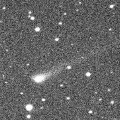
|
Although it had been unobservable for a while, it is appearing in the morning sky. Now it is 15.2 mag (Feb. 6, Taras Prystavski). It keeps bright as 13-14 mag for a long time from 2013 to 2014.
Date(TT) R.A. (2000) Decl. Delta r Elong. m1 Best Time(A, h)
Feb. 8 18 56.31 -26 37.8 3.801 3.065 36 14.7 5:27 (306, 3)
Feb. 15 19 8.00 -26 33.5 3.739 3.063 40 14.6 5:21 (308, 5)
|
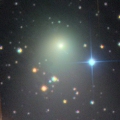
|
It became much brighter than expected, and reached up to 8.5 mag (Aug. 15, Alexandre Amorim). Now it is fading, but it is bright as 13.8 mag still now (Jan. 28, Taras Prystavski). In the Southern Hemisphere, it will keep observable in good condition for a long time until 2014 summer when the comet fades out. It will never be observable again in the Northern Hemisphere.
Date(TT) R.A. (2000) Decl. Delta r Elong. m1 Best Time(A, h)
Feb. 8 16 47.52 -68 20.0 2.942 2.737 68 14.7 5:27 (348,-16)
Feb. 15 16 58.61 -68 46.7 2.949 2.808 72 14.9 5:21 (349,-16)
|

|
Big asteroid discovered in 1906. It suddenly showed the cometary activity on Dec. 11, 2010, probably due to an impact of a small object. It has already turned to be stellar.
Date(TT) R.A. (2000) Decl. Delta r Elong. m1 Best Time(A, h)
Feb. 8 0 55.25 -3 59.9 3.745 3.245 52 15.1 19:00 ( 61, 29)
Feb. 15 1 2.51 -2 51.0 3.832 3.253 47 15.1 19:06 ( 67, 25)
|
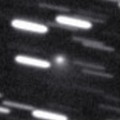
|
Now it is 14.7 mag (Jan. 19, Taras Prystavski). It keeps 15 mag until March, and will be observable in excellent condition in the Northern Hemisphere. It locates low in the Southern Hemisphere.
Date(TT) R.A. (2000) Decl. Delta r Elong. m1 Best Time(A, h)
Feb. 8 4 33.41 34 55.7 1.167 1.792 112 15.4 19:21 ( 0, 90)
Feb. 15 4 45.04 34 7.4 1.214 1.784 107 15.4 19:06 ( 20, 89)
|

|
It brightened up to 14.0 mag from spring to summer in 2013 (June 11, Sandor Szabo). Now it is 14.9 mag, much brighter than origianlly predicted (Jan. 27, Taras Prystavski). In the Northern Hemisphere, it will be observable at 15-16 mag in excellent condition until spring. It locates somewhat low in the Southern Hemisphere.
Date(TT) R.A. (2000) Decl. Delta r Elong. m1 Best Time(A, h)
Feb. 8 13 39.88 15 53.4 3.565 4.133 118 15.4 4:29 ( 0, 71)
Feb. 15 13 34.24 18 7.4 3.505 4.170 126 15.5 3:56 ( 0, 73)
|
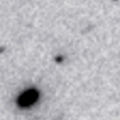
|
It is expected to brighten up to 13 mag and to be observable in good condition in 2015. Now it is 15.9 mag (Jan. 26, Taras Prystavski). In 2014, it will be observable at 15 mag in good condition from winter to summer.
Date(TT) R.A. (2000) Decl. Delta r Elong. m1 Best Time(A, h)
Feb. 8 13 59.38 -4 41.8 4.694 5.106 109 15.9 4:48 ( 0, 50)
Feb. 15 14 0.81 -4 31.3 4.551 5.064 116 15.8 4:22 ( 0, 50)
|
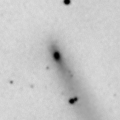
|
Now it is 15.7 mag (Jan. 27, Taras Prystavski), brighter than origianlly predicted. It will be observable at 14-16 mag for a long time from 2013 to 2014.
Date(TT) R.A. (2000) Decl. Delta r Elong. m1 Best Time(A, h)
Feb. 8 16 0.83 -22 15.8 4.101 3.985 76 16.0 5:27 (338, 29)
Feb. 15 16 6.01 -22 40.5 4.009 3.996 82 16.0 5:21 (342, 30)
|
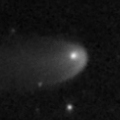
|
Now it is 15.1 mag (Jan. 20, Taras Prystavski). It will be fading after this, but it keeps brighter than 18 mag until 2015 spring.
Date(TT) R.A. (2000) Decl. Delta r Elong. m1 Best Time(A, h)
Feb. 8 3 4.31 -17 0.4 7.821 7.724 80 16.1 19:00 ( 21, 36)
Feb. 15 3 4.59 -16 7.4 7.953 7.757 75 16.1 19:06 ( 30, 33)
|

|
Now it is 16.6 mag (Jan. 11, Taras Prystavski). It brightens up to 15.5 mag from spring to summer, and will be observable in excellent condition in the Southern Hemisphere. It locates somewhat low in the Northern Hemispehre.
Date(TT) R.A. (2000) Decl. Delta r Elong. m1 Best Time(A, h)
Feb. 8 8 4.24 -25 12.4 1.647 2.447 135 16.5 22:50 ( 0, 30)
Feb. 15 7 59.22 -25 29.3 1.615 2.397 132 16.3 22:17 ( 0, 29)
|

|
Now it is 17.0 mag (Jan. 24, A. Klotz, F. Kugel). It keeps close to the earth around 0.7 a.u. until spring. It will brighten up to 16.5 mag in February and March, and will be observable in excellent condition in the Northern Hemisphere. It locates very low in the Southern Hemisphere.
Date(TT) R.A. (2000) Decl. Delta r Elong. m1 Best Time(A, h)
Feb. 8 2 19.07 30 46.8 0.655 1.126 84 16.6 19:00 ( 88, 66)
Feb. 15 2 49.05 32 36.2 0.641 1.119 83 16.5 19:06 ( 93, 66)
|

|
Now it is 15.8 mag (Jan. 18, Taras Prystavski). It keeps 16 mag for a long time until 2015 summer. It keeps observable in good condition in the Northern Hemisphere. It becomes observable only after 2015 in the Southern Hemisphere.
Date(TT) R.A. (2000) Decl. Delta r Elong. m1 Best Time(A, h)
Feb. 8 4 36.33 53 12.8 3.687 4.168 112 16.5 19:23 (180, 72)
Feb. 15 4 37.13 53 3.0 3.739 4.135 106 16.5 19:06 (175, 72)
|

|
Now it is 17.2 mag (Jan. 12, P. C. Sherrod). It will approach to the earth down to 0.68 a.u., brighten up to 16 mag, and will be observable in excellent condition in spring.
Date(TT) R.A. (2000) Decl. Delta r Elong. m1 Best Time(A, h)
Feb. 8 12 32.11 29 36.3 0.900 1.742 134 16.8 3:21 ( 0, 85)
Feb. 15 12 25.68 28 14.2 0.836 1.722 141 16.6 2:48 ( 0, 83)
|

|
It approached to the sun down to 0.73 A.U. on 2013 Mar. 24, and brightened up to 4.7 mag (Mar. 11, Michael Mattiazzo). Now it is fading. It has already faded down to 16.5 mag (Jan. 1, G. Dangl). In the Northern Hemisphere, it keeps observable in good condition while fading gradually. In the Southern Hemisphere, it will never be observable again.
Date(TT) R.A. (2000) Decl. Delta r Elong. m1 Best Time(A, h)
Feb. 8 20 36.90 52 10.5 4.802 4.528 68 16.7 5:27 (224, 27)
Feb. 15 20 44.44 53 7.4 4.886 4.601 67 16.9 5:21 (223, 30)
|

|
It brightened up to 12-13 mag from autumn to winter in 2012. Now it is fading. But actually, it is 15.7 mag, brighter than this ephemeris (Jan. 26, Taras Prystavski). It will be observable until April in the Northern Hemisphere, or May in the Southern Hemisphere.
Date(TT) R.A. (2000) Decl. Delta r Elong. m1 Best Time(A, h)
Feb. 8 5 32.60 -2 7.2 4.485 5.049 119 16.8 20:19 ( 0, 53)
Feb. 15 5 32.39 -1 55.1 4.618 5.096 113 16.9 19:51 ( 0, 53)
|
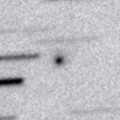
|
Now it is 16.6 mag (Jan. 7, Toshiyuki Takahashi). It is expected to brighten up to 6 mag in 2014 autumn. At this time, it keeps observable while brightening gradually until April when it becomes 16 mag.
Date(TT) R.A. (2000) Decl. Delta r Elong. m1 Best Time(A, h)
Feb. 8 5 26.80 21 24.0 2.992 3.629 123 17.0 20:13 ( 0, 76)
Feb. 15 5 17.70 21 1.5 3.027 3.547 114 16.9 19:36 ( 0, 76)
|
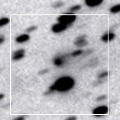
|
Now it is 16.9 mag (Jan. 29, Taras Prystavski). It tends to be brightest 4 months after the perihelion passage. However, it has already started fading. It will be fainter than 18 mag in March.
Date(TT) R.A. (2000) Decl. Delta r Elong. m1 Best Time(A, h)
Feb. 8 5 54.43 22 21.3 1.735 2.485 129 17.0 20:41 ( 0, 77)
Feb. 15 5 56.20 22 43.3 1.841 2.520 123 17.3 20:15 ( 0, 78)
|
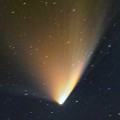
|
It passed the perihelion on 2013 Mar. 10, and brightened up to 0-1 mag. Now it is fading. It has already faded down to 15.8 mag (Jan. 15, Ken-ichi Kadota). It will keep 16-17 mag until spring. It is not observable in the Southern Hemisphere.
Date(TT) R.A. (2000) Decl. Delta r Elong. m1 Best Time(A, h)
Feb. 8 17 18.16 28 44.4 5.201 5.021 74 17.1 5:27 (269, 56)
Feb. 15 17 20.29 29 30.4 5.205 5.095 78 17.2 5:21 (271, 60)
|
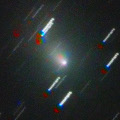
|
It brightened up to 9-10 mag in 2013 spring. Now it is fading. It has faded down to 15.8 mag in October (Oct. 7, Hidetaka Sato). In the Southern Hemisphere, it keeps observable for a long time until the comet fades out, although it keeps locating low. However, it has not been observed after November. It will never be observable again in the Northern Hemisphere.
Date(TT) R.A. (2000) Decl. Delta r Elong. m1 Best Time(A, h)
Feb. 8 17 27.68 -67 39.4 4.030 3.716 64 17.2 5:27 (344,-18)
Feb. 15 17 37.71 -68 3.8 4.033 3.784 68 17.3 5:21 (346,-17)
|
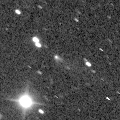
|
Now it is 17.4 mag (Jan. 4, Catalina Sky Survey). It keeps 17 mag for a long time from 2013 summer to early 2015.
Date(TT) R.A. (2000) Decl. Delta r Elong. m1 Best Time(A, h)
Feb. 8 2 12.20 14 14.7 3.111 3.040 76 17.2 19:00 ( 60, 56)
Feb. 15 2 19.87 14 43.9 3.201 3.037 71 17.3 19:06 ( 68, 51)
|

|
First return of a new periodic comet which brightened up to 13 mag in outburst in 2008. It will be observable in good condition from spring to summer. But the brightness is uncertain. It was not detected, fainter than 21.0 mag on Jan. 6 (Jost Jahn).
Date(TT) R.A. (2000) Decl. Delta r Elong. m1 Best Time(A, h)
Feb. 8 12 48.48 9 50.1 1.908 2.655 130 17.6 3:37 ( 0, 65)
Feb. 15 12 49.11 10 28.3 1.827 2.636 136 17.4 3:11 ( 0, 65)
|
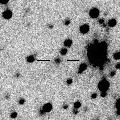
|
Now it is 17.6 mag (Jan. 27, K. Sarneczky). It keeps observable at 18 mag for a long time from 2013 to 2016. It keeps locating high in the Northern Hemisphere. It keeps locating very low in the Southern Hemipshere.
Date(TT) R.A. (2000) Decl. Delta r Elong. m1 Best Time(A, h)
Feb. 8 19 8.36 28 13.4 7.115 6.593 54 17.5 5:27 (257, 33)
Feb. 15 19 10.63 29 9.6 7.062 6.583 57 17.4 5:21 (258, 37)
|

|
Now it is 17.6 mag (Jan. 19, Taras Prystavski). It will approach to the earth down to 0.06 a.u. from May to June, and it is expected to brighten up to 11 mag. In the Northern Hemisphere, it keeps observable in excellent condition until the highlight in late May while the comet will be brightening rapidly. In the Southern Hemisphere, it is not observable now. But it will be observable in mid May. Then it keeps observable in excellent condition at the highlight and after that while the comet will be fading.
Date(TT) R.A. (2000) Decl. Delta r Elong. m1 Best Time(A, h)
Feb. 8 8 39.50 67 33.7 0.697 1.513 127 17.6 23:24 (180, 57)
Feb. 15 8 17.07 69 57.8 0.669 1.450 120 17.4 22:34 (180, 55)
|

|
It keeps 17-18 mag for a long time from 2013 to 2014. It is observable in excellent condition in the Southern Hemisphere. It is not observable in the Northern Hemisphere.
Date(TT) R.A. (2000) Decl. Delta r Elong. m1 Best Time(A, h)
Feb. 8 14 35.71 -49 6.5 4.644 4.688 86 17.5 5:25 ( 0, 6)
Feb. 15 14 30.82 -50 43.4 4.535 4.684 92 17.5 4:52 ( 0, 4)
|

|
Now it is 19.0 mag (Dec. 31, Hidetaka Sato). It keeps observable at 17.5 mag until June.
Date(TT) R.A. (2000) Decl. Delta r Elong. m1 Best Time(A, h)
Feb. 8 16 38.67 -20 26.3 2.299 2.134 67 17.7 5:27 (328, 28)
Feb. 15 16 52.20 -20 42.5 2.235 2.144 71 17.7 5:21 (330, 28)
|

|
Now it is 17.4 mag (Jan. 15, A. Hidas). It is expected to brighten up to 14 mag from autumn to winter in 2015. The condition is excellent in the Southern Hemisphere, and it keeps observable for a long time after this while the comet will be brightening. In the Northern Hemisphere, it will be unobservable in late March.
Date(TT) R.A. (2000) Decl. Delta r Elong. m1 Best Time(A, h)
Feb. 8 5 23.99 -36 18.0 5.923 6.225 103 17.8 20:10 ( 0, 19)
Feb. 15 5 18.65 -35 11.7 5.947 6.185 99 17.8 19:37 ( 0, 20)
|

|
Fading rapidly. Now it is 15.7 mag (Jan. 5, Taras Prystavski). However, the central nucleus is so faint as 19.0 mag (Jan. 12, Martin Masek). It locates high in the Southern Hemisphere. But it will be too faint to observe soon. It locates extremely low in the Northern Hemisphere.
Date(TT) R.A. (2000) Decl. Delta r Elong. m1 Best Time(A, h)
Feb. 8 13 27.70 -47 47.9 2.352 2.662 97 17.8 4:17 ( 0, 7)
Feb. 15 13 24.19 -49 34.4 2.351 2.737 102 18.0 3:46 ( 0, 5)
|

|
It keeps 18 mag for a very long time from 2013 to 2018. It locates high in the Southern Hemisphere. But it locates somewhat low in the Northern Hemisphere.
Date(TT) R.A. (2000) Decl. Delta r Elong. m1 Best Time(A, h)
Feb. 8 11 13.82 -19 31.6 8.633 9.371 136 17.9 2:03 ( 0, 35)
Feb. 15 11 12.21 -19 30.4 8.565 9.365 142 17.9 1:34 ( 0, 35)
|

|
Now it is 18.2 mag (Jan. 18, Taras Prystavski). It will brighten up to 14 mag around the perihelion passage in 2019. In 2013, it will be observable in good condition at 18 mag from summer to winter. It locates low in the Southern Hemisphere.
Date(TT) R.A. (2000) Decl. Delta r Elong. m1 Best Time(A, h)
Feb. 8 2 41.58 27 6.7 13.400 13.392 87 17.9 19:00 ( 75, 69)
Feb. 15 2 42.09 27 10.9 13.489 13.364 80 17.9 19:06 ( 83, 62)
|
|
![]()
 169P/NEAT
169P/NEAT 290P/2013 N1 ( Jager )
290P/2013 N1 ( Jager ) 154P/Brewington
154P/Brewington 17P/Holmes
17P/Holmes C/2006 S3 ( LONEOS )
C/2006 S3 ( LONEOS ) 4P/Faye
4P/Faye 134P/Kowal-Vavrova
134P/Kowal-Vavrova 29P/Schwassmann-Wachmann 1
29P/Schwassmann-Wachmann 1 C/2011 J2 ( LINEAR )
C/2011 J2 ( LINEAR ) C/2013 V1 ( Boattini )
C/2013 V1 ( Boattini ) C/2013 A1 ( Siding Spring )
C/2013 A1 ( Siding Spring ) C/2010 S1 ( LINEAR )
C/2010 S1 ( LINEAR ) 117P/Helin-Roman-Alu 1
117P/Helin-Roman-Alu 1 C/2012 V2 ( LINEAR )
C/2012 V2 ( LINEAR ) (596) Scheila
(596) Scheila 52P/Harrington-Abell
52P/Harrington-Abell C/2012 K6 ( McNaught )
C/2012 K6 ( McNaught ) C/2012 F3 ( PanSTARRS )
C/2012 F3 ( PanSTARRS ) P/2012 B1 ( PanSTARRS )
P/2012 B1 ( PanSTARRS ) C/2009 F4 ( McNaught )
C/2009 F4 ( McNaught ) C/2013 Y2 ( PanSTARRS )
C/2013 Y2 ( PanSTARRS ) P/2013 TL117 ( Lemmon )
P/2013 TL117 ( Lemmon ) C/2013 V2 ( Borisov )
C/2013 V2 ( Borisov ) 124P/Mrkos
124P/Mrkos C/2012 F6 ( Lemmon )
C/2012 F6 ( Lemmon ) C/2012 J1 ( Catalina )
C/2012 J1 ( Catalina ) C/2013 V5 ( Oukaimeden )
C/2013 V5 ( Oukaimeden ) 84P/Giclas
84P/Giclas C/2011 L4 ( PanSTARRS )
C/2011 L4 ( PanSTARRS ) C/2012 L2 ( LINEAR )
C/2012 L2 ( LINEAR ) 119P/Parker-Hartley
119P/Parker-Hartley P/2008 J2 ( Beshore )
P/2008 J2 ( Beshore ) C/2012 K8 ( Lemmon )
C/2012 K8 ( Lemmon ) 209P/LINEAR
209P/LINEAR C/2013 G7 ( McNaught )
C/2013 G7 ( McNaught ) 87P/Bus
87P/Bus C/2014 A4 ( SONEAR )
C/2014 A4 ( SONEAR ) C/2013 N4 ( Borisov )
C/2013 N4 ( Borisov ) C/2013 C2 ( Tenagra )
C/2013 C2 ( Tenagra ) C/2010 U3 ( Boattini )
C/2010 U3 ( Boattini )![]()




































